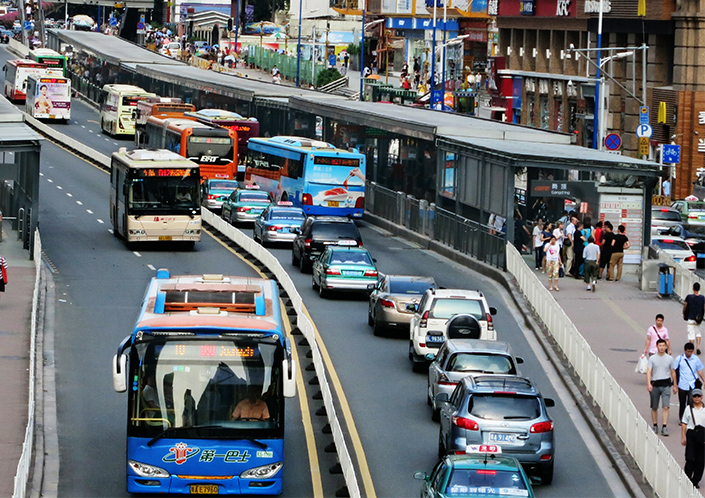26 July 2016
Mixed traffic is now allowed to use BRT lanes during the peak hour, degrading the performance of the Guangzhou BRT system.
The Guangzhou Communications Commission in May 2016 issued the Zhongshan Avenue BRT Management Regulation 《中山大道快速公交系统管理办法》 stipulating that in peak hours cars can enter the BRT lanes under the guidance of traffic police, when facing congestion.

Shidajida BRT station, picture above, has the highest BRT bus throughput in the world after Transmilenio in Bogota, with 240 buses per hour in the citybound direction in the morning peak. This is 4 buses per minute, with one bus passing every 15 seconds. The Guangzhou BRT has the second-most efficient BRT bus lanes in the world after Bogota, with the BRT lanes carrying 20,800 people in a single direction past a single point during the peak hour (passengers per hour per direction or pphpd), compared to around 2,000 pphpd in a typical car lane. This passenger flow is higher than in any BRT lanes in the world except for Transmilenio. By contrast, few BRT systems worldwide carry more than 10,000 pphpd, with most carrying less than 5,000 pphpd. While other BRT systems have segregated lanes, mixed traffic is now regularly allowed into Guangzhou's BRT lanes.
The Guangzhou BRT's peak hour speeds are now around 16km/hr compared to 20km/hr with enforced segregation, with the speed reduction leading to a downgrading of Guangzhou's BRT standard score from 'gold' to 'silver'. The degraded performance has also led to a reduction in passenger demand as public transport becomes a less attractive option, with maximum passenger throughput down from around 28,000 pphpd in previous years to 23,000 pphpd in 2016. At the same time as passenger throughput has declined, crowding has increased to extreme levels, with an average 87 passengers per bus in the citybound direction compared to an average of 78 passengers per bus in 2014. This overcrowding is exacerbated by the slower bus speeds which means buses can make less trips during the peak hour, and further reduces the attractiveness of the BRT to passengers. BRT bus overcrowding also makes boarding and alighting much slower, which further reduces the system speed and capacity.
The mixed traffic incursion into the Guangzhou BRT lanes and stations are actively encouraged and promoted by the Traffic Police.
Guangzhou's BRT system is also undermined by operation of 4 phase intersections at Tianhe Donglu and Tiyu Donglu intersections. These poorly performing intersections degrade the BRT speed as well as negatively impacting mixed traffic.
It should be noted that while the speed and crowding has been adversely affected by these approaches to mixed traffic incursions and 4-phase intersections, other key reasons for poor performance include the lack of any significant procurement of 18m BRT buses and improvements to routes especially to reduce transfers.




 Mixed traffic is now allowed to enter BRT lanes and stations. These photos show Shidajida, Chebei, Tiyu Zhongxin and Gangding BRT stations during the peak hour.
Mixed traffic is now allowed to enter BRT lanes and stations. These photos show Shidajida, Chebei, Tiyu Zhongxin and Gangding BRT stations during the peak hour.